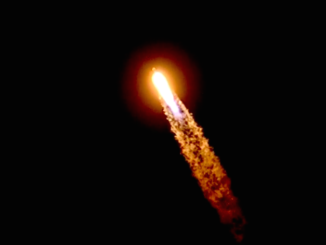EDITOR’S NOTE: Updated at 10:30 p.m. EDT (0230 GMT) with details.
SpaceX’s launch team loaded liquid propellants into the company’s first upgraded Falcon 9 Block 5 rocket Friday at the Kennedy Space Center in Florida, and the countdown rehearsal culminated in a brief ignition of the launcher’s nine Merlin main engines on the launch pad.
The hold-down test-firing occurred at 7:25 p.m. EDT (2325 GMT) Friday on pad 39A at NASA’s Kennedy Space Center, passing a major milestone in preparation for launch of the upgraded Falcon 9, which features changes SpaceX says will make the rocket more reusable and more reliable.
After a data review to examine how the rocket and ground systems performed during Friday evening’s hotfire test, SpaceX will connect the Falcon 9 rocket to its payload — the French-built Bangabandhu 1 communications satellite for the government of Bangladesh — inside a nearby hangar, then return the vehicle to launch pad.
SpaceX confirmed a good outcome of the static fire test in a tweet Friday evening.
Falcon 9 Block 5 static fire test complete ahead of next week’s launch of Bangladesh’s first geostationary communications satellite. Vehicle is healthy. Data review will take a few days—will confirm a target launch date once that review is complete.
— SpaceX (@SpaceX) May 5, 2018
Liftoff was targeted for Monday at 4:06 p.m. EDT (2006 GMT), but SpaceX’s statement suggested the mission will be delayed later next week. The company typically releases target launch dates shortly after a successful static fire test.
The launch time is not expected to change significantly on other potential launch dates next week.
The changes introduced on the Block 5 configuration of the Falcon 9 rocket include updates to make the Falcon 9 rocket meet NASA’s human-rating requirements. There are also modifications to allow SpaceX to recover and reuse first stage boosters with greater speed.
It will be the first rocket launch from pad 39A since SpaceX’s first Falcon Heavy launcher, made by bolting three Falcon 9 first stage boosters together, lifted off from the Space Coast on Feb. 6.
“Block 5 basically summarizes all that we learned on reusability,” said Hans Koenigsmann, vice president of build and flight reliability at SpaceX, in a briefing last month. “Whenever we recover a booster and then it goes through refurbishment, we find things that are giving us … lessons for the next block. In this case, we tried to summarize all of these lessons learned into a booster that then is able to fly, and be recovered and fly again multiple times without a lot of refurbishment.
“That’s basically the key thing on Block 5,” Koenigsmann said. “It’s a reliability update that combines reliability and reusability.”
One of the major changes on the Block 5 version of the Falcon 9 is the addition of more resilient heat shield material at the base of the rocket’s first stage, according to Koenigsmann.
The Block 5 version of the Falcon 9 also incorporates changes to meet NASA safety requirements for launches with astronauts heading for the International Space Station.
“Block 5 is the last big spin on Falcon 9, and it’s largely driven by the upgrade that we needed to make for the commercial crew program, as well as national security space launch requirements,” said Gwynne Shotwell, SpaceX’s president and chief operating officer, during a question-and-answer session with reporters last year.
Email the author.
Follow Stephen Clark on Twitter: @StephenClark1.



